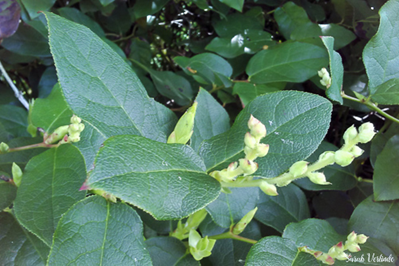Salal
Gaultheria shallon – Salal
At a Glance:

- Family: Ericaceae
- Plant Type: dense, low-growing evergreen shrub
- Distribution: Pacific Coast, California to Alaska, mostly west of the Cascade Crest
- Habitat: woods and forests low to mid-elevations, often found with Douglas-fir (Pseudotsuga menziesii)
- Height: 1-10 feet, on average 2-4 feet
- Flower/Fruits: white bell/urn shaped flowers on a raceme, droop and open downward with a pink/red tinge. Fruits are purple-black, looking like a berry and are covered in small hairs.
- Flowering Season: May – July
- Leaves: leathery and medium to dark green on the upper side, with a pale green underside. They are ovate to ovate-elliptical, 2-4 inches, with a finely serrate margin.
- Generation: Perennial
- Bark: twigs are reddish-brown and mature stems can have peeling bark.
- Fun Fact: leaves live 2-4 years and will generate at different times, so the plant always has leaves. Stems/twigs live for 16 years or more. Most of the plant’s biomass is underground, and in many cases, the roots live for hundreds of years.
Restoration and Conservation
Salal leaves are an important food source for black-tail and mule deer. Mountain beavers, elk and the white-footed vole seasonally depend on the leaves. The berries are eaten by many birds and mammals – including bears and humans. Hummingbirds and other pollinators use the nectar in the flowers. Salal has evergreen leaves and a shrubby form providing year round coverage and shelter for birds and small mammals. In between salal plants, deer and elk can use the spaces as cover and shelter, making it a great place to hide and be protected from winds.
Ethnobotany
Pacific Northwest tribes (Klallam, Makah, Kwakiuti, Nitinaht and many others) relied heavily on salal, especially the fruits. The berries were collected and eaten fresh, or dried and saved for winter months. Modern day use of the fruits include making them into a jam or jelly. The branches were used to line pits and provided a seasoning to the fish or meat that was cooked.
Salal is an important native plant used heavily in the landscape trade, it is easy to grow and adaptable to sunny or shady areas. It is a very important crop collected (or cultivated) for the floral industry for use as a foliage.
References and Resources
- FEIS/USDA: https://www.fs.fed.us/database/feis/plants/shrub/gausha/all.html
- PFAF: https://pfaf.org/user/plant.aspx?latinname=Gaultheria+shallon
- NAEB: http://naeb.brit.org/uses/search/?string=Gaultheria+shallon
- WTU Image Herbarium: http://biology.burke.washington.edu/herbarium/imagecollection/taxon.php?Taxon=Gaultheria%20shallon
This article was written by Sarah Verlinde. For questions regarding the UWB/CC Plant Tour, contact Sarah at severlin@uw.edu.
